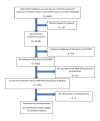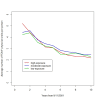The Duration of an Exposure Response Gradient between Incident Obstructive Airways Disease and Work at the World Trade Center Site: 2001-2011
- PMID: 26064784
- PMCID: PMC4449208
- DOI: 10.1371/currents.dis.8a93e7682624698558a76a1fa8c5893f
The Duration of an Exposure Response Gradient between Incident Obstructive Airways Disease and Work at the World Trade Center Site: 2001-2011
Abstract
Background: Adverse respiratory effects of World Trade Center (WTC) exposure have been widely documented, but the length of time that exposure remains associated with disease is uncertain. We estimate the incidence of new cases of physician-diagnosed obstructive airway disease (OAD) as a function of time since 9/11/2001 in WTC-exposed firefighters.
Methods: Exposure was categorized by first WTC arrival time: high (9/11/2001 AM); moderate (9/11/2001 PM or 9/12/2001); or low (9/13-24/2001). We modeled relative rates (RR) and 95% confidence intervals (CI) of OAD incidence by exposure over the first 10 years post-9/11/2001, estimating the time(s) of change in the RR with change point models. We further examined the relationship between self-reported lower respiratory symptoms and physician diagnoses.
Results: Change points were observed at 15 and 84 months post-9/11/2001, with relative incidence rates for the high versus low exposure group of 4.02 (95% CI 2.62-6.16) prior to 15 months, 1.90 (95% CI 1.49-2.44) from months 16 to 84, and 1.20 (95% CI 0.92-1.56) thereafter. Incidence in all exposure groups increased after the WTC health program began to offer free coverage of OAD medications in month 63. Self-reported lower respiratory symptoms in the first 15 months had 80.6% sensitivity, but only 35.9% specificity, for eventual OAD diagnoses.
Conclusions: New OAD diagnoses are associated with WTC exposure for at least seven years. Some portion of the extended duration of that association may be due to delayed diagnoses. Nevertheless, our results support recognizing OAD among rescue workers as WTC-related even when diagnosed years after exposure.
Figures
References
-
- Prezant DJ, Levin S, Kelly KJ, Aldrich TK. Upper and lower respiratory diseases after occupational and environmental disasters. Mt Sinai J Med. 2008 Mar-Apr;75(2):89-100. PubMed PMID:18500710. - PubMed
-
- Thurston GD, Bates DV. Air pollution as an underappreciated cause of asthma symptoms. JAMA. 2003 Oct 8;290(14):1915-7. PubMed PMID:14532321. - PubMed
-
- De Leon SF, Thurston GD, Ito K. Contribution of respiratory disease to nonrespiratory mortality associations with air pollution. Am J Respir Crit Care Med. 2003 Apr 15;167(8):1117-23. PubMed PMID:12684250. - PubMed
-
- Chatkin JM, Tarlo SM, Liss G, Banks D, Broder I. The outcome of asthma related to workplace irritant exposures: a comparison of irritant-induced asthma and irritant aggravation of asthma. Chest. 1999 Dec;116(6):1780-5. PubMed PMID:10593805. - PubMed
-
- Kogevinas M, Zock JP, Jarvis D, Kromhout H, Lillienberg L, Plana E, Radon K, Torén K, Alliksoo A, Benke G, Blanc PD, Dahlman-Hoglund A, D'Errico A, Héry M, Kennedy S, Kunzli N, Leynaert B, Mirabelli MC, Muniozguren N, Norbäck D, Olivieri M, Payo F, Villani S, van Sprundel M, Urrutia I, Wieslander G, Sunyer J, Antó JM. Exposure to substances in the workplace and new-onset asthma: an international prospective population-based study (ECRHS-II). Lancet. 2007 Jul 28;370(9584):336-41. PubMed PMID:17662882. - PubMed
Grants and funding
LinkOut - more resources
Full Text Sources
Other Literature Sources




